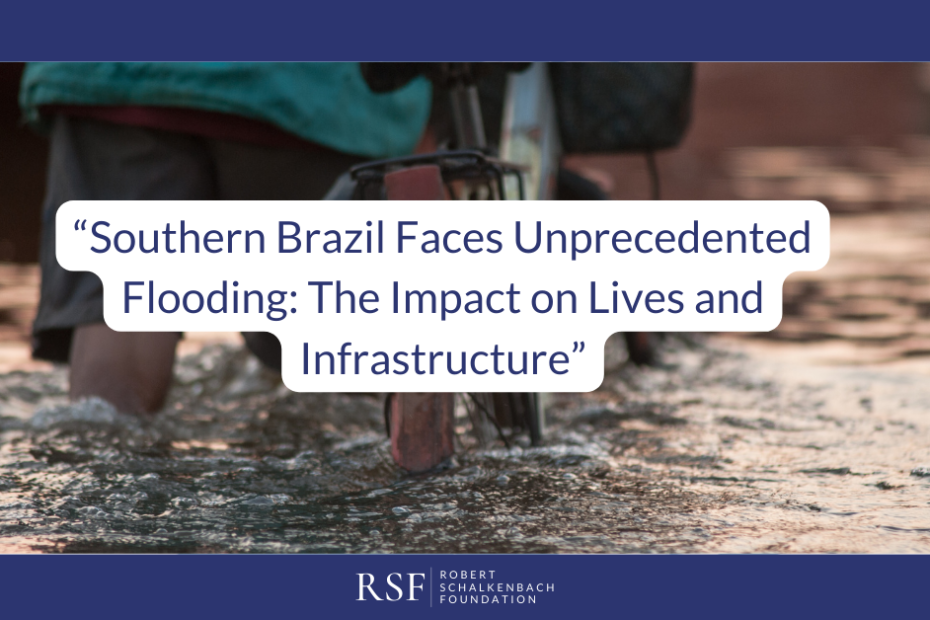Southern Brazil has suffered five extra tropical cyclones in the last 12 months, but the most recent disaster has caused flooding which led to immense devastation to everything from farms, infrastructure to homes. Southern Brazil is currently experiencing the effects of an especially strong El Niño, a climate phenomenon describing the periodic warming of sea surface temperatures in the central and eastern Pacific Ocean.
In Southern Brazil, a strong El Niño can lead to intense, frequent storms and tropical cyclones. However, even without considering the effects of this year’s El Niño, human-driven climate change was a significant contributor.
The level of damage to cities and towns is unprecedented, and estimates of damage to homes and infrastructure are still unavailable due to the water still in the areas. The most affected regions—Porto Alegre, Rio Pardo of Rio Grande do Sul and Taquari Valleys have experienced near complete destruction. Many of these municipalities are home to farms, factories, and meat industries. The flooding has impacted more than two million people and over 640,000 people have been displaced out of a total population of around 10.9 million. At least 169 lives have been lost, and another 44 people are still missing.
Many flood victims who had to evacuate their homes with nowhere to go are sheltering in public buildings such as schools, churches, sports arenas and gymnasiums. Because these places must eventually return to their normal operations, the federal government is planning to build temporary structures with bedrooms, bathrooms, kitchens and laundry units for flood victims. The state of Rio Grande do Sul estimates that around 15% of flood victims will need long-term accommodations beyond staying in the temporary structures. Most are expected to either return home, live with relatives or friends outside of Southern Brazil, or find other alternatives.
In addition to building temporary shelters, President Luiz Inacio Lula da Silva announced nearly 1.2 billion reais ($226 million USD) in direct federal aid to about 240,000 families that have lost their homes. Each family is expected to receive at least 5,100 reais ($992) in this initial cash payment. The payment is only a fraction of the total disaster recovery funding announced thus far by the federal government’s 12.1 billion reais ($2.26B USD) which covers infrastructure repair, medical aid, housing assistance, nutritional assistance and more.
For families who are still living in their homes, many are still living without running water or electricity and transportation. In the most affected areas, large parts of highways and roads are inaccessible due to landslides, collapsed bridges or being submerged. The Salgado Filho International Airport in Rio Grande do Sul’s capital, Porto Alegre, has been closed due to flooding that reached as high as 2.5 meters in some terminals.
In addition to damage and threats to economic well-being, threats to health are also looming. Epidemiologists warn that floodwater exacerbates the spread of disease. This is because floodwaters are often contaminated by fecal matter which facilitate the spread of hepatitis A/B and typhoid fever. Zoonotic diseases are also a significant concern because water flowing around in streets usually becomes infected with rodent urine. In addition, the lack of access to clean running water leads to diarrhea outbreaks when contaminated water is consumed. Currently, there have been 50 confirmed cases of leptospirosis and 4 associated deaths.
A forecast by experts at the Institute of Hydraulic Research in Brazil estimated that water levels could take weeks to recede and drain out, but conditions could clear up as soon as mid-June. This timeline is based on what was observed during Southern Brazil’s historic flooding in 1941. However, recovery times will depend on weather conditions and could be extended further if rain continues.
World Weather Attribution, an organization that conducts studies about extreme weather events analyzed the factors that contributed to the magnitude of the flooding and damage. They cite climate change, lack of investment and maintenance of flood management infrastructure, deforestation and rapid urbanization without proper flood mitigation infrastructure.
Experts at World Weather Attribution note that in Porto Alegre, floodgates that were designed to manage flood waters up to 6 meters began to fail at 4.5 meters. This signals that existing infrastructure must be reexamined and upgraded to address future flooding, which is expected to become more frequent and intense due to climate change.
Besides the government response, many organizations have been working on the ground to provide aid. Brazil-based nonprofit organizations such as Brazilian Red Cross and Movimento União Brazil are working to make a difference and are accepting donations through their website.
References:
Flood’s impact on farmers: https://www.reuters.com/investigates/special-report/brazil-rains-farmers/
Overview and economic impact: https://apnews.com/article/brazil-floods-economy-environment-climate-change-4e49b3ecc857253a5c23946208c58cfc
Overview with climate change perspective: https://www.wri.org/insights/tragic-flooding-brazil-building-resilience
Airport information: https://brazilreports.com/what-to-know-about-airport-closures-after-flooding-in-southern-brazil/6133/
Natural Disasters Topline Report: https://brazilreports.com/natural-disasters-cost-brazil-125-billion-from-2013-to-2023-report/6117/
Health warnings/implications: https://brazilreports.com/four-die-of-leptospirosis-brazil-authorities-warn-of-other-diseases-following-floods/6125/
Disaster Recovery Numbers https://www.reuters.com/world/americas/death-toll-rains-brazils-south-reaches-143-govt-announces-emergency-spending-2024-05-12/#:~:text=On%20Saturday%20evening%20the%20government,population%20of%20around%2010.9%20million.
Recovery timeline estimates: https://www.reuters.com/world/americas/brazil-flooding-will-take-weeks-subside-experts-warn-2024-05-15/
U.S. support/response: https://br.usembassy.gov/ongoing-u-s-support-for-flood-affected-communities-in-rs/
Study/analysis on contributors to flooding conditions: https://earth.org/southern-brazil-floods-made-twice-as-likely-due-to-climate-change-report/
World Weather Attribution Study: https://www.worldweatherattribution.org/climate-change-made-the-floods-in-southern-brazil-twice-as-likely/
Health Impacts Overview: https://www.ncbi.nlm.nih.gov/pmc/articles/PMC11136508/#:~:text=Floodwaters%2C%20often%20contaminated%20by%20fecal,%2C%20and%20leptospirosis%205%20%2D%207%20.
Disease Outbreak: https://www.telegraph.co.uk/global-health/climate-and-people/brazil-floods-leptospirosis-disease-outbreak-deaths/

